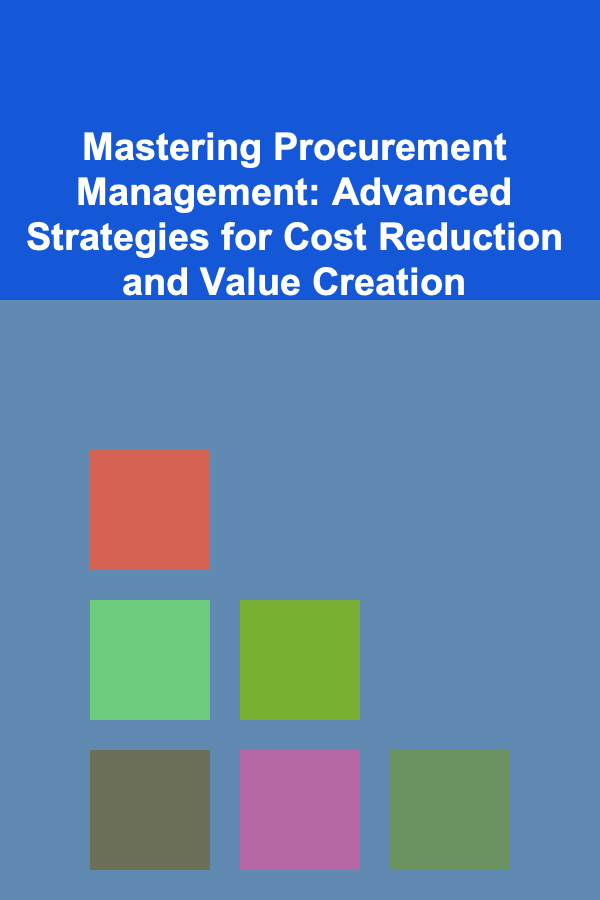
Mastering Procurement Management: Advanced Strategies for Cost Reduction and Value Creation
ebook include PDF & Audio bundle (Micro Guide)
$12.99$9.99
Limited Time Offer! Order within the next:

Procurement management is a vital function in organizations that directly impacts both the bottom line and operational efficiency. As businesses continue to face complex challenges such as globalization, supply chain disruptions, and fluctuating market demands, mastering advanced procurement strategies is key to achieving sustainable cost reduction and creating long-term value. This guide delves into the advanced strategies that procurement professionals can implement to optimize their purchasing operations, enhance supplier relationships, and contribute to the strategic growth of their organizations.
Strategic Sourcing for Long-Term Value
Strategic sourcing goes beyond traditional purchasing methods by aligning procurement decisions with an organization's overall goals and long-term objectives. By identifying key suppliers and focusing on total cost management rather than just unit price, procurement managers can drive substantial cost savings and add significant value.
Key Actions:
- Spend Analysis: Begin by analyzing your company's procurement spend to identify patterns, opportunities for consolidation, and areas where excessive costs may arise. Categorizing spend into strategic, routine, and leverage categories helps prioritize efforts.
- Total Cost of Ownership (TCO): Consider the full lifecycle cost of a product or service rather than just its upfront price. TCO includes factors like maintenance, warranties, shipping, training, and disposal costs. For example, a supplier offering lower initial prices but higher maintenance costs could result in higher overall expenditures.
- Supplier Evaluation and Selection: Move beyond price comparisons. Evaluate suppliers based on quality, reliability, innovation potential, and their ability to align with your company's values. Selecting suppliers based on these criteria enables long-term, mutually beneficial partnerships.
Leveraging Technology for Procurement Efficiency
The procurement function is increasingly becoming technology-driven. From automating routine tasks to using advanced data analytics for better decision-making, technology plays a significant role in streamlining procurement processes and driving both cost reduction and value creation.
Key Actions:
- E-Procurement Systems: Implement e-procurement platforms that automate the procurement process, reducing human error, improving compliance, and increasing efficiency. These platforms streamline everything from requisition to invoicing, enabling procurement teams to focus on more strategic tasks.
- Supplier Relationship Management (SRM) Software: Use SRM tools to track and monitor supplier performance, manage contracts, and strengthen communication. This centralized system allows procurement managers to evaluate suppliers' consistency and reliability more effectively.
- Data Analytics: Utilize predictive analytics to forecast demand, monitor supplier performance, and identify cost-saving opportunities. Data-driven insights can also help in risk management by identifying supply chain bottlenecks, market trends, and potential disruptions before they impact operations.
Supplier Collaboration and Innovation
A key component of advanced procurement management is transitioning from a transactional approach to a collaborative one. Strong supplier relationships are no longer just about negotiating the best prices but about fostering collaboration and co-innovation to create value for both parties.
Key Actions:
- Joint Development Initiatives: Work with suppliers to develop new products or improve existing offerings. By involving suppliers early in the product development process, you can tap into their expertise and innovation, reducing time-to-market and improving quality.
- Supplier Performance Reviews: Conduct regular reviews with key suppliers to evaluate performance against agreed metrics such as on-time delivery, product quality, and sustainability efforts. Use these reviews as opportunities to discuss improvements, new technologies, or cost-saving initiatives.
- Risk Sharing: In cases where suppliers may be exposed to risks that affect their ability to meet contractual obligations, consider negotiating risk-sharing agreements. This could involve providing incentives for suppliers to adopt innovative solutions that mitigate risks in the supply chain.
Advanced Negotiation Techniques
Negotiation remains one of the most critical skills for procurement managers. However, in today's competitive and globalized market, traditional negotiation tactics are no longer enough. Advanced negotiation strategies are focused on creating win-win situations, developing long-term relationships, and ensuring that all parties derive value from the agreement.
Key Actions:
- Understand the Supplier's Position: Advanced negotiators understand that effective negotiations require knowledge of both their own company's needs and the supplier's situation. Understanding a supplier's constraints and priorities can lead to creative solutions that benefit both sides.
- Leverage Data and Market Intelligence: Use data and market intelligence to negotiate better terms. This can include historical pricing trends, supply and demand forecasts, and competitor offers. Armed with accurate and timely information, procurement managers can negotiate from a position of strength.
- Multi-Tier Negotiations: Negotiate across multiple levels of an organization, not just with the supplier's sales team. Engaging with higher-level decision-makers on both sides can help you secure more favorable terms and establish a more strategic relationship.
Agile Procurement Practices
As businesses face increasingly volatile market conditions, agility has become a crucial attribute for procurement teams. An agile procurement strategy enables businesses to respond quickly to changes in demand, disruptions in supply, and shifts in market dynamics.
Key Actions:
- Decentralized Decision-Making: Empower procurement teams to make quicker decisions based on localized information. For example, in a global organization, regional procurement managers should have the autonomy to adjust purchasing decisions based on local market conditions.
- Scenario Planning: Use scenario planning to anticipate potential risks and uncertainties. By evaluating different "what-if" scenarios, procurement managers can better prepare for disruptions and adjust sourcing strategies on the fly.
- Flexible Contracts: Negotiate flexible contracts that allow for changes in quantity, delivery schedules, and pricing in response to market conditions. This flexibility can help mitigate the impact of supply chain disruptions and price fluctuations.
Sustainable Procurement and Ethical Sourcing
In an era of increased corporate social responsibility, sustainable procurement and ethical sourcing are no longer optional---they are expected by stakeholders, including consumers, investors, and regulators. Procurement managers who adopt sustainable practices contribute to environmental conservation, fair labor practices, and long-term value creation.
Key Actions:
- Supplier Sustainability Audits: Regularly audit suppliers for their sustainability practices. This includes assessing their environmental impact, labor conditions, and adherence to ethical standards. Suppliers that align with sustainability values can help improve the company's reputation and reduce reputational risks.
- Green Procurement: Shift towards environmentally friendly sourcing practices by considering the environmental impact of products and services. Opt for energy-efficient products, recyclable materials, and suppliers with strong sustainability credentials.
- Social Responsibility: Consider social factors when selecting suppliers. Work with suppliers that maintain ethical labor standards and treat their workers fairly. This not only strengthens the brand's reputation but also minimizes the risk of supply chain disruptions due to unethical practices.
Advanced Risk Management in Procurement
In today's interconnected and volatile global market, procurement managers must be prepared to manage and mitigate risks that could disrupt the supply chain. Advanced risk management strategies focus on identifying, assessing, and minimizing procurement-related risks, ranging from geopolitical instability to supplier bankruptcy.
Key Actions:
- Risk Mapping and Assessment: Conduct a thorough risk assessment of your supply chain, identifying potential risks from suppliers, logistics providers, and external factors such as weather disruptions or geopolitical events. Map these risks to assess their likelihood and potential impact.
- Diversification of Suppliers: Avoid single-source dependency by diversifying your supplier base. This reduces the risk of supply chain disruptions due to the failure of a single supplier or region. Consider near-shoring or reshoring strategies to reduce geopolitical risks.
- Risk Transfer and Mitigation: Explore strategies like insurance, hedging, or multi-supplier agreements to transfer or share procurement risks. For instance, purchasing insurance for key supply chain risks or negotiating contracts that allow for flexible pricing during periods of market volatility can reduce financial exposure.
Continuous Improvement and Professional Development
Procurement is an evolving field, and staying ahead of industry trends, regulations, and best practices is essential. Continuously improving procurement processes and investing in professional development ensures that procurement teams are well-equipped to meet the demands of a dynamic business environment.
Key Actions:
- Benchmarking: Regularly benchmark procurement processes against industry best practices. This allows procurement managers to identify areas of improvement, optimize workflows, and incorporate successful strategies from other organizations.
- Training and Development: Invest in continuous learning and professional development for procurement teams. Encourage certifications in procurement management, attend industry conferences, and stay updated on regulatory changes and technological advancements.
- Foster a Culture of Innovation: Encourage team members to think creatively about solving procurement challenges. A culture of innovation within the procurement team leads to the identification of new cost-saving opportunities, process improvements, and supplier collaboration strategies.
Conclusion
Mastering procurement management requires a combination of strategic thinking, technological adoption, supplier collaboration, and continuous risk management. By implementing these advanced strategies, procurement professionals can achieve meaningful cost reductions, enhance supplier relationships, and contribute to long-term value creation for their organizations. As procurement continues to evolve, the ability to adapt to market changes, leverage technology, and focus on sustainable and ethical sourcing will be critical to sustaining competitive advantage and fostering growth. By mastering these elements, procurement managers will be equipped to drive both immediate and sustained success in a rapidly changing global marketplace.
Reading More From Our Other Websites
- [Ziplining Tip 101] The Zipline Challenge: Turning a Thrill Ride into a Blueprint for New Beginnings
- [Personal Care Tips 101] How to Choose a Long-Wearing Foundation for Special Events
- [Sewing Tip 101] Genius Sewing Hacks Every Beginner Should Know
- [Home Budget 101] How to Cut Back on Subscription Services and Stay on Budget
- [Home Rental Property 101] How to Rent a House with an In-Law Suite: A Guide for Multi-Generational Families
- [Home Budget Decorating 101] How to Add Texture and Warmth to Your Home on a Budget
- [Home Cleaning 101] How to Speed Clean Your Home in Less Than an Hour
- [Home Renovating 101] How to Replace Old Windows and Save on Energy Costs
- [Home Storage Solution 101] How to Store Your Wine Collection in Style and Safety
- [Home Budget Decorating 101] How to Decorate Your Bedroom on a Small Budget

How to Handle Pet Waste Disposal in Your Home
Read More
How to Profit from Deep Learning by Licensing Your Models
Read More
How to Use Storage Ottomans for Dual Purpose Organization
Read More
How To Start Your First Print-on-Demand Business
Read More
How to Predict Drug-Drug Interactions Using Pharmacological Principles
Read More
10 Tips for a Minimalist Morning Routine Checklist
Read MoreOther Products

How to Handle Pet Waste Disposal in Your Home
Read More
How to Profit from Deep Learning by Licensing Your Models
Read More
How to Use Storage Ottomans for Dual Purpose Organization
Read More
How To Start Your First Print-on-Demand Business
Read More
How to Predict Drug-Drug Interactions Using Pharmacological Principles
Read More